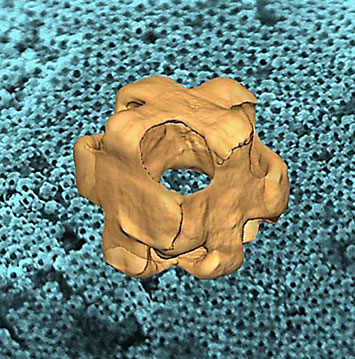Engineered Nanowrappers Carry and Release Cargo
innovation at CFN
March 18, 2019
 enlarge
enlarge
(Center) 3D electron tomogram of a hollow Au-Ag nanowrapper. (Background) Scanning electron mircoscope image of a large-area of nanowrappers assembled into a superlattice.
What is the scientific achievement?
CFN Staff have discovered a new method to synthesize hollow metallic nanostructures with surface openings, which can carry and deliver cargos of guest nanoobjects. These nanowrappers have unique optical signatures originating from plasmonic effects and their complex nanoarchitecture. Advanced electron tomography provides 3D images at different stages of synthesis, which tracks their transition from Ag nanocubes with sharp corners to Au-Ag alloy nanowrappers with large cubic pores at all corners.
Why does this achievement matter?
This research is a promising new strategy for synthesis of porous, 3D nanoarchitectures. Nanowrappers have biomedical potential as photothermal therapeutics, vehicles for photoinduced drug delivery, or agents for improved imaging contrast.
What are the details?
Hollow nanoparticles are of broad interest for biomedical, optical, and catalytic applications due to their unique geometry-related physicochemical properties. The ability to engineer hollow structures with surface openings is particularly attractive since emergent properties are promised by the design of shell porosity and encapsulation of guest materials. However, it still remains challenging to precisely control the shape, size, and location of the openings in hollow structures. This work presents a one-step strategy to synthesize hollow nanostructures with well-defined cubic-shape openings at the corners, by regulating nanoscale galvanic replacement processes with specific surface-capping agents. The final product is a single-crystalline AuAg alloy which morphologically features three “belts” orthogonally wrapping around a virtual cube, which we call a nanowrapper. We demonstrate the structural tunability of our synthetic method for tailoring nanowrappers, and the corresponding tuning of their plasmonic band from the visible to near-infrared wavelength range. Advanced electron tomography techniques provide unambiguous three-dimensional (3D) visualizations and reveal an unconventional transformation pathway of sharp-cornered Ag nanocubes to nanowrappers, and correlate structure with measured and computed spectroscopic properties. Importantly, we find that the surfactant used during synthesis (cetylpyridinium chloride (CPC)) is crucial for the openings to be localized at the corners of the hollow cube and be tailored to a cubic shape. Furthermore, such a well-defined hollow architecture also allows a guest nano-object to be contained within, while the large openings at the corners enable controlled loading and release of nanoscale cargo, a DNA-coated particle, through changes in ionic conditions. This work expands our understanding of surface engineering in nanoscale galvanic replacement reactions and opens new ways toward the shape control of hollow NPs.
CFN Capabilities:
CFN Materials Synthesis facilities were used to prepare the nanowrapper samples, and the Electron Microscopy Facility was used to characterize them.
Publication Reference
F. Lu, H. L. Xin, W. W. Xia, M. Z. Liu, Y. G. Zhang, W. P. Cai, O. Gang, Tailoring Surface Opening of Hollow Nanocubes and Their Application as Nanocargo Carriers, ACS Central Science 4, 1742 (2018).
DOI: 10.1021/acscentsci.8b00778
https://www.sciencedaily.com/releases/2019/01/190103120857.htm
https://www.bnl.gov/newsroom/news.php?a=113285
Acknowledgement of Support
The research was carried out at the Center for Functional Nanomaterials of Brookhaven National Laboratory, supported by the U.S. Department of Energy, Office of Basic Energy Sciences, under Contract DE-SC0012704. This work was also supported by the Natural Science Foundation of China (Grants 51531006 and 11574313).
2019-14462 | INT/EXT | Newsroom











